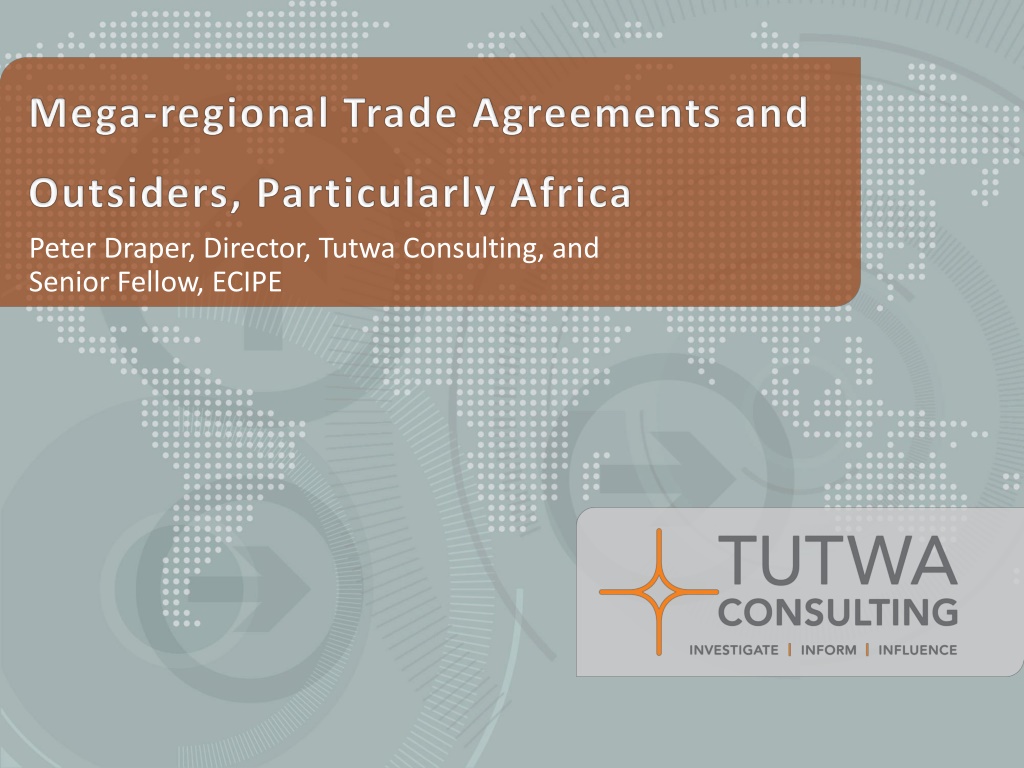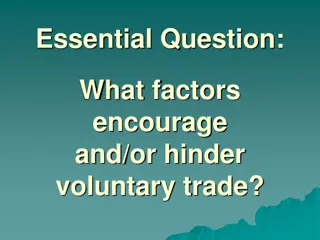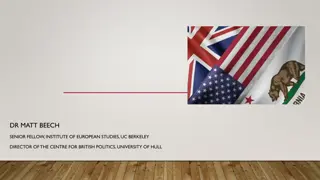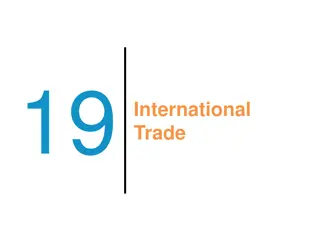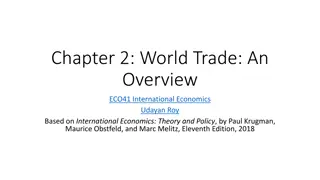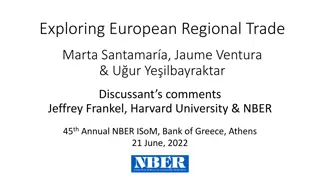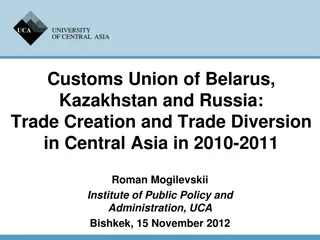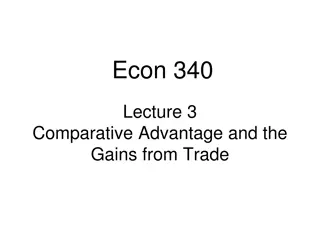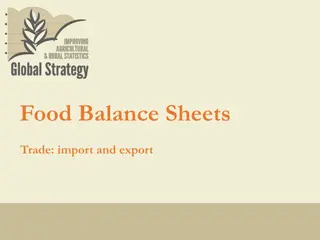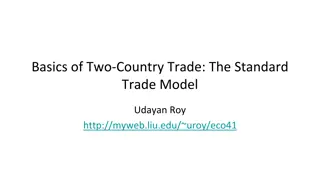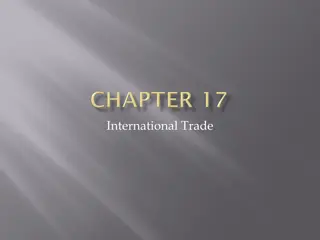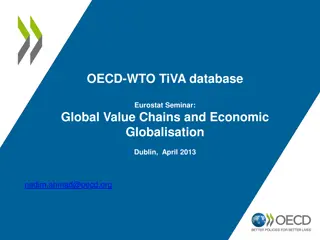Global Trade Dynamics: Mega-Regionals and Strategic Implications
Examining the impact of mega-regionals like TTIP and TPP on global trade dynamics, focusing on regulatory agendas, outcomes scenarios, and strategic challenges for developing countries. The growth of regionalism in contrast to the WTO's stasis, the significance of systemically important trade agreements, and the predicted impacts of tariff liberalization and regulatory harmonization are discussed.
Download Presentation

Please find below an Image/Link to download the presentation.
The content on the website is provided AS IS for your information and personal use only. It may not be sold, licensed, or shared on other websites without obtaining consent from the author. Download presentation by click this link. If you encounter any issues during the download, it is possible that the publisher has removed the file from their server.
E N D
Presentation Transcript
Peter Draper, Director, Tutwa Consulting, and Senior Fellow, ECIPE
Background Which mega-regionals matter most, and why? The regulatory agenda: A brief review Outcome scenarios Strategic implications for outsiders, especially developing countries
Growth of regionalism in inverse proportion to relative stasis in WTO Opportunities for advancing rules are higher in smaller, like-minded groups Western leadership of the global trading system in play given the rise of China and other emerging markets Combination of regulatory demand and geopolitical drive explains TPP and TTIP Whether successful or not they present serious strategic challenges to outsiders, especially developing countries
Focus on the most systemically significant Our definition (ECIPE report): 3 or more countries a. 25% or more of world trade b. WTO plus, or deep regulatory agenda c. Only TTIP, TPP, and RCEP meet conditions 1 and 2 Only TTIP and TPP meet all three Quite a number of other RTAs that are significant but not considered (eg Japan-EU; Canada-EU)
Review of impact studies Tariff liberalization impacts on negotiating parties predicted to be modest, since tariffs are generally not high to begin with a. Varies between TTIP, TPP states, and by sector b. Trade diversion effects on non-parties similarly predicted to be relatively small c. Again varying according to sector and negotiation I. Owing to high trade complementarities between ACP states and US/EU II. Some studies predict that trade creation (the GVC effect) may lead to net gains for outsiders d.
Regulatory impacts predicted to be substantial Overall effects very difficult to predict, and any attempt to do so probably shouldn t be believed But the regulatory agenda is very much part of the RTA landscape and won t go away Effects could be of two types: Ratcheting up of standards through harmonization, leading to lock-out effect a. Reduction of market access costs through mutual recognition/equivalence b.
How mutual recognition could be beneficial to outsiders (WEF Report)
Sequencing is key to understanding: TPP leads; TTIP follows Both aim for a high standard agreement The US is central to both, therefore focus on US negotiating templates TPP covers 29 chapters under a single undertaking Our focus (ECIPE Report): Areas not covered by multilateral disciplines incorporating all members of the WTO a. Areas already covered by the WTO bearing closer scrutiny b.
Select WTO plus issues: Regulatory coherence oversight councils/bodies and role of business groups a. SOEs trade distorting practices or competitive neutrality ; linkage to competition policy b. Government procurement incorporation of GPA by reference (2011 text) c. Competition exclusions; dispute settlement d.
Investment dispute settlement; capital controls, non-conforming measures e. E-commerce freedom of access and competition; data privacy f. Environment incorporation of MEAs; dispute settlement (enforceability) g. Labour enforceability through DSM h.
Other issues expected to push the status quo: Goods market access construction of tariff offers; rules of origin; entrenched lobbies especially in agriculture (eg Japanese rice) a. SPS science-based risk assessments; dispute settlement b. Services negative vs positive lists c. IPR US vs the rest on patents; US vs EU on GIs d.
Definition of success? Ours (ECIPE report): Globally systemic view (not rooted in particular country interests) a. Agreement that all negotiating states are happy with b. Major liberalizing outcomes c. Key blockages in the international trading system addressed d.
Full success Utopian scenario a. Not likely since many compromises entailed in both negotiations b. Partial success Most likely a. Messier than US bilateral FTAs, but substantial liberalization and harmonization that developing country parties can live with b. Failure Least likely a. Hinges on US trade politics, especially TPA b.
Calibrate to the outcome scenarios Full success = competitive liberalization Watch China s posture in particular (TPP; TISA; RCEP) a. Entails great pressure on ACP countries to sign up bilaterally and in the WTO b. More pressure for reciprocity c.
Partial success More wriggle room for ACP, but a. Failure of major western powers to decisively assert leadership of the trading system implies further WTO stasis b. Therefore more pressure on the bilateral front down the line, not least to compete with rise of emerging markets particularly China c. Reciprocity still very much on the table, if not imminent d.
Failure Western trade leadership foregone a. Acceleration of China s potential leadership role b. Balancing option for ACP more pronounced c. But what does China want? d. Also, developed countries likely to intensify search for reciprocity with attendant implications for preferences e.
Policy options Do nothing always an option but it seems there is nowhere to hide a. Sequenced embrace of liberalization and regulatory reform, tailored to domestic capacities (ideal-type depiction) b. Unilateral reforms, driven by careful review of regulatory agenda contained in I. mega-regionals Regionally, through RTAs with neighbours and using appropriately designed II. models Regionally, with small developed economies that are not so threatening III. Regionally, with the major powers IV.
WTO c. Proactive, positive discussion of regulatory agenda I. Engage positively with the idea of plurilaterals on the basis of deliberations on II. the regulatory agenda Forge a consensus on how plurilaterals could proceed without harming own III. interests (eg: plurilaterals code of conduct )
They could Ensure that standards convergence does not lead to lock-out by extending recognition of conformity assessments a. Direct more aid for trade funding towards standards- setting/implementation agencies in African LDCs b. Remove arbitrary distortions that inhibit African participation in GVCs c. Eg: Different rules of origin for LDCs versus non-LDCs
